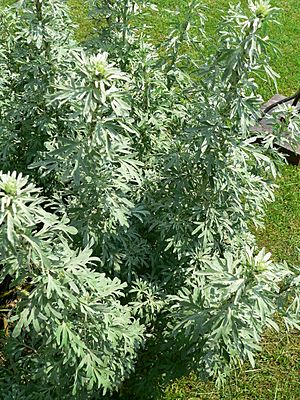Wormwood facts for kids
Quick facts for kids Wormwood |
|
|---|---|
 |
|
| Wormwood growing wild in the Caucasus | |
| Scientific classification | |
| Kingdom: | |
| (unranked): | |
| (unranked): | |
| (unranked): | |
| Order: | |
| Family: | |
| Genus: | |
| Species: |
A. absinthium
|
| Binomial name | |
| Artemisia absinthium |
|
Wormwood (also known as artemisia absinthium, absinthe wormwood, common wormwood, Green Ginger, or grand wormwood) is a fascinating plant. It is native to areas with mild climates in Eurasia and northern Africa. This means you can find it growing naturally across a large part of the world.
Wormwood is well-known for its strong smell and bitter taste. It has been used for hundreds of years for different purposes. Let's explore what makes this plant so special!
Contents
What is Wormwood?
Wormwood is a type of herb or small shrub. It belongs to the Asteraceae family, which is also known as the daisy or sunflower family. This family includes many common plants you might recognize.
How Does Wormwood Look?
Wormwood plants can grow up to 1 meter (about 3 feet) tall. They have silvery-green leaves that are covered in fine, silky hairs. These hairs give the plant a soft, fuzzy look. The leaves are deeply divided, almost like feathers.
The plant produces small, yellowish-green flowers. These flowers are not very showy. They grow in clusters at the end of the stems. The flowers usually appear in the late summer, from July to September.
Where Does Wormwood Grow?
Wormwood prefers sunny spots and dry soil. You can often find it growing in rocky areas, along roadsides, or in fields. It is a very tough plant that can survive in many different conditions. It grows wild in many parts of Europe, Asia, and North Africa.
The Life Cycle of Wormwood
Wormwood is a perennial plant. This means it lives for more than two years. It can come back year after year from its roots.
How Does Wormwood Reproduce?
Wormwood mainly reproduces through its seeds. After the flowers bloom, they produce tiny seeds. These seeds are then spread by the wind or by animals. If the seeds land in a good spot, they will sprout and grow into new plants.
The plant can also spread through its roots. New shoots can grow from the root system, helping the plant to spread and form larger patches. This makes it quite resilient.
Uses of Wormwood Through History
Wormwood has a long history of being used by people. Ancient civilizations knew about this plant.
Traditional Uses of Wormwood
For centuries, wormwood was used in traditional medicine. People believed it could help with various health issues. It was often used to help with digestion or to get rid of parasites.
It was also used as an insect repellent. People would hang bundles of wormwood in their homes. This was thought to keep away fleas and moths.
Wormwood in Beverages
One of the most famous uses of wormwood is in a drink called Absinthe. Absinthe is an alcoholic spirit that was very popular in the 19th century. It has a distinct green color and a strong flavor.
Wormwood gives Absinthe its unique taste. However, Absinthe also contains a substance called thujone. In the past, people thought thujone caused strange effects. Because of this, Absinthe was banned in many countries for a long time. Today, Absinthe is allowed again in most places, but with strict rules about how much thujone it can contain.
Wormwood is also sometimes used to flavor other drinks. These include some types of vermouth and bitters. These drinks often have a slightly bitter taste.
Interesting Facts About Wormwood
- The name Artemisia comes from Artemis, the Greek goddess of the hunt.
- The word absinthium comes from the Greek word meaning "undrinkable" or "without sweetness," referring to its bitter taste.
- Wormwood is sometimes planted in gardens. It can help to keep certain pests away from other plants.
- Despite its bitterness, some animals, like deer, will eat wormwood.
Images for kids
-
Wormwood growing wild in the Caucasus


